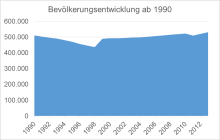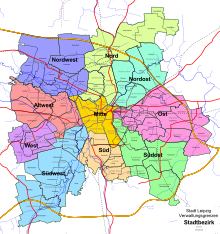Population development of Leipzig
This article shows the population development of Leipzig in a table.
Population development
In the Middle Ages and the early modern period , the population of Leipzig grew only slowly and fell again and again through numerous wars, epidemics and famine. In 1639, 4,229 people died in a plague epidemic . In 1800 the city had a population of 32,000 until the industrial revolution started a strong population growth. With the high level of industrialization in Germany , Leipzig became a major city in 1870 .
Towards the end of the 19th century the growth was increased by incorporations and the city had around 400,000 inhabitants in 1895. The city received a further significant increase when the earlier surrounding villages Möckern , Probstheida , Stünz , Stötteritz , Dölitz and Dosen were incorporated into the city in early 1910 . Leipzig grew to a population of 580,000 people, which was higher than that of the then state capital Dresden . On December 1, 1910, the cut-off date for the census in the German Reich , there were almost 590,000 Leipzig residents. After further incorporations, the population reached its historical high of 718,200 in 1930 during the Weimar Republic .
In the "Greater German Reich" Leipzig was in May 1939, 707,365 inhabitants on rank 6 of the list of Germany's largest cities , with Vienna is taken into account. During the Second World War , the population fell by almost 18 percent (125,000 people), mainly due to flight and evacuations such as the “ extended Kinderlandverschickung ”, in which schoolchildren and mothers with small children from cities threatened by the air war were housed in less endangered areas for longer periods.
Around 6,000 people died in the air raids on Leipzig , 1,800 of them in the heaviest attack on December 4, 1943. Between 1942 and 1945, around 2,000 Jewish people were deported from the city , around 1,800 of whom were murdered. The population fell to 582,000 by December 1945, rose again to 617,000 by 1950, and then fell back to 530,000 by the fall of the GDR . Between 1990 and 1998 the population decreased by about 18 percent to 437,000 people as a result of strong suburbanization (urban flight), supra-regional emigration and the drop in birth rates.
In 2005 there were again over 500,000 people living in Leipzig. This is an increase of 63,000 inhabitants compared to 1998. This increase is partly due to the incorporation of surrounding municipalities in 1999 and 2000. Adjusted for incorporations, Leipzig lost around 4.6% of its inhabitants between 1990 and 2012, but gained 4.0% with incorporations, with the city area doubling. For some years now, the core city has also benefited from significant gains in migration. On December 31, 2011, the “ official population ” for Leipzig was 510,043 according to an update by the State Statistical Office of the Free State of Saxony (only main residences and after comparison with the other state offices). While Leipzig was fourth behind Munich on the list of the largest German cities in 1946 with just under 608,000 inhabitants , the city fell back to thirteenth in 2010 .
The following overview shows the number of inhabitants according to the respective territorial status. Up to 1825 these are mostly estimates, then census results (¹) or official updates from the city administration (until 1944), the state central administration for statistics (1945 to 1989) and the state statistical office (from 1990). From 1834 the information relates to the “customs clearance population”, from 1871 to the “local population”, from 1925 to the resident population and since 1966 to the “population at the place of the main residence”. Before 1834, the number of inhabitants was determined according to inconsistent survey methods.
From 1165 to 1940
(respective territorial status)
|
|
|
¹ census result
² incorporations
From 1945 to 1989
(respective territorial status)
|
|
|
¹ census result
Source: State Central Administration for Statistics
Since 1990
(respective territorial status)
|
|
|
¹ Incorporation
² Census result ( 2011 census )
³ Increase compared to May 9, 2011
Source: State Statistical Office of the Free State of Saxony
Population forecast
In their Guide to Demographic Change 2020 published in 2006 , in which the Bertelsmann Foundation provides data on the development of the population of 2,959 municipalities in Germany, an increase in Leipzig's population of 1.8 percent (8,912 people) is predicted between 2003 and 2020. A study by the same foundation published in December 2008 corrected this forecast significantly upwards.
In 2007, the State Statistical Office of the Free State of Saxony published the 4th regionalized population forecast for the Free State of Saxony up to 2020 in three different versions. The variants do not differ in their calculation models, but in different data sets. Variant 1 calculates the absolute population for the years 2010 and 2020 on the basis of assumptions made by the State Office on life expectancy and migration exchange, Variants 2 and 3 calculate the absolute population for the years 2010 and 2020 on the basis of preliminary and final assumptions by the Federal Statistical Office predicted decrease in population. Based on the state data, the population will continue to rise until 2020.
Absolute population development 2003-2025 - forecast for Leipzig (main residences):
| date | Bertelsmann Foundation residents (2006) |
Bertelsmann Foundation residents (2008) |
Inhabitants State Statistical Office, variant 1 |
Inhabitants State Statistical Office, variant 2 |
Inhabitants State Statistical Office, variant 3 |
Inhabitants State Statistical Office, 5th forecast (2011) |
|---|---|---|---|---|---|---|
| December 31, 2003 | 497,531 | - | - | - | - | - |
| December 31, 2005 | 498.717 | 502,700 1 | 502,700 1 | 502,700 1 | 502,700 1 | 502,700 1 |
| December 31, 2010 | 502.998 | 514.132 | 513,000 | 511,400 | 512,300 | 521.510 1 |
| December 31, 2015 | 507.479 | 520.067 | k. A. | k. A. | k. A. | 532,600 |
| December 31, 2020 | 506.443 | 523.060 | 520.100 | 506,700 | 507,900 | 538,500 |
| December 31, 2025 | k. A. | 523.057 | k. A. | k. A. | k. A. | 538,600 |
Source: Bertelsmann Foundation
1 Actual number of inhabitants as of December 31 of the year
Absolute population development 2009-2030 - forecast for Leipzig (main residences):
| date | Residents |
|---|---|
| December 31, 2009 | 518,540 |
| December 31, 2015 | 540,360 |
| December 31, 2020 | 553.220 |
| December 31, 2025 | 561,470 |
| December 31, 2030 | 564,380 |
Source: Bertelsmann Foundation
Population forecast for the city of Leipzig 2016:
| year | Pessimistic variant |
Main variant | Optimistic variant |
|---|---|---|---|
| 2016 | 585,000 | 584.100 | 590,000 |
| 2017 | 595,000 | 598,300 | 605,000 |
| 2018 | 605,000 | 611,000 | 620,000 |
| 2019 | 612,500 | 622,800 | 635,000 |
| 2020 | 620,000 | 633,700 | 650,000 |
| 2025 | 655,000 | 681,600 | 710,000 |
| 2030 | 675,000 | 721.800 | 760,000 |
Data basis: Numbers from the population register, which in 2014 were around 7,400 more than the official population of the State Statistical Office of the Free State of Saxony
Source: Office for Statistics and Elections Leipzig
Population structure
| population | As of December 31, 2009 | As of December 31, 2015 |
|---|---|---|
| Residents with main residence | 518,862 | 560.472 |
| of which male | 251,748 | 274.414 |
| Female | 267.114 | 286.058 |
| German | 486,564 | 518.473 |
| Foreigners | 32,298 | 41,999 |
| Proportion of foreigners in percent | 6.2 | 7.5 |
Source: State Statistical Office of the Free State of Saxony
Population with a migration background
| rank | Country | Foreigners | German | Migration background (December 31, 2017) |
|---|---|---|---|---|
| 1. |
|
3.126 | 5,324 | 8,450 |
| 2. |
|
7,923 | 518 | 8,441 |
| 3. |
|
2,861 | 1,780 | 4,641 |
| 4th |
|
3,161 | 437 | 3,598 |
| 5. |
|
2,440 | 991 | 3,431 |
| 6th |
|
2.223 | 1,198 | 3,421 |
| 7th |
|
2,105 | 668 | 2,773 |
| 8th. |
|
1,461 | 855 | 2,316 |
| 9. |
|
237 | 1,967 | 2,204 |
| 10. |
|
1,775 | 225 | 2,000 |
At the end of 2017 there were 83,406 people with a migration background in Leipzig (56,011 foreigners, 27,395 German citizens), of which 25,061 were migrants from EU countries (18,516 foreigners, 6,545 German citizens).
age structure
The population figures refer to December 31, 2008 (main residences).
| Age from - to | Population 2008 | Share in percent 2008 | Population 2016 | Share in percent 2016 |
|---|---|---|---|---|
| 0 - 5 | 22,417 | 4.3 | 30,849 | 5.3 |
| 5 - 10 | 18,112 | 3.5 | 25,694 | 4.4 |
| 10-15 | 14,026 | 2.7 | 21,031 | 3.6 |
| 15-20 | 19,559 | 3.8 | 21,741 | 3.8 |
| 20-25 | 39,632 | 7.7 | 34,807 | 6.0 |
| 25-30 | 45,818 | 8.9 | 57,801 | 10.0 |
| 30-35 | 36,449 | 7.1 | 53,987 | 9.3 |
| 35-40 | 34,780 | 6.7 | 44,750 | 7.7 |
| 40-45 | 39,601 | 7.7 | 31,724 | 5.5 |
| 45 - 50 | 38,319 | 7.4 | 36,222 | 6.3 |
| 50-55 | 33,073 | 6.4 | 37.906 | 6.5 |
| 55-60 | 32,897 | 6.4 | 32,912 | 5.7 |
| 60-65 | 25,529 | 5.0 | 31,004 | 5.3 |
| 65-70 | 37.110 | 7.2 | 26,862 | 4.6 |
| 70 - 75 | 31,143 | 6.0 | 25,858 | 4.5 |
| 75-80 | 20,157 | 3.9 | 31,374 | 5.4 |
| 80-85 | 14,349 | 2.8 | 19,126 | 3.3 |
| 85 u. Ä. | 12,498 | 2.4 | 15,882 | 2.7 |
| total | 515,469 | 100.0 | 579,530 | 100 |
Source: State Statistical Office of the Free State of Saxony for 2008, Statistical Yearbook 2017 of the City of Leipzig for 2016
Townships
The urban area of Leipzig is divided into ten city districts. The city districts are in turn divided into districts and these are further subdivided into statistical districts (see list of city districts and districts of Leipzig ). Below the statistical districts there are also blocks and block pages ( small-scale structure ). However, this political and statistical structure is only partially based on the urban districts that have grown. (see list of districts of Leipzig ).
The population figures refer to December 31, 2016 (main residences).
| Surname | Area in km² |
of inhabitants number |
Inhabitants per km² |
Number of foreigners |
Foreigners in percent |
|---|---|---|---|---|---|
| Old West | 26.1 | 56,877 | 2,180 | 4,325 | 7.6 |
| center | 13.9 | 62,648 | 4,510 | 9,657 | 15.4 |
| North | 38.4 | 68,791 | 1,794 | 4,638 | 6.7 |
| Northeast | 26.3 | 46,452 | 1,766 | 3,918 | 8.4 |
| northwest | 39.1 | 31,812 | 814 | 2.174 | 6.8 |
| east | 40.7 | 81,998 | 2013 | 11,484 | 14th |
| south | 16.9 | 65.507 | 3,871 | 3,821 | 5.8 |
| Southeast | 34.6 | 59,147 | 1,706 | 3,469 | 5.9 |
| southwest | 46.7 | 53,830 | 1,153 | 3,212 | 6.0 |
| west | 14.7 | 52,460 | 3,571 | 5.163 | 9.8 |
| Leipzig | 297.4 | 579,530 | 1,949 | 51,861 | 8.9 |
Source: Office for Statistics and Elections of the City of Leipzig
See also
literature
- Imperial Statistical Office (Ed.): Statistical Yearbook for the German Empire , 1880–1918
- Statistisches Reichsamt (Ed.): Statistical yearbook for the German Reich , 1919–1941 / 42
- German Association of Cities (Ed.): Statistical Yearbook of German Communities , 1890 ff.
- State Central Administration for Statistics (Ed.): Statistical Yearbook of the German Democratic Republic , 1955–1989
- Bertelsmann Stiftung (Ed.): Guide to Demographic Change 2020. Analyzes and action plans for cities and municipalities. Bertelsmann Stiftung Publishing House, Gütersloh 2006, ISBN 3-89204-875-4
- Hartmut Zwahr : The population movement of the city of Leipzig, its border, suburban and outer villages in the course of the industrial revolution in Germany. in: Sächsische Heimatblätter , issue 4/1973, pp. 156–160
Web links
- Leipzig information system
- State statistical office of the Free State of Saxony: area, population
- State Statistical Office of the Free State of Saxony: GENESIS-Online
- City administration Leipzig: Statistical information service
- Bertelsmann Stiftung: Guide to the community
Individual evidence
- ↑ Annual chronicle 1910 at www.dhm.de.
- ^ Steffen Held: Jews in Leipzig. A historical overview. In: Volker Rodekamp (ed.): Traces of Jewish life in Leipzig. (Publications of the City History Museum Leipzig)
- ↑ Tobias Kaiser: The fairy tale of flourishing East German cities. In: welt.de . March 4, 2015, accessed July 4, 2015 .
- ↑ http://www.statistik.sachsen.de/download/010_GB-Bev/Bev_Gemeinde.pdf
- ↑ a b c d e State Statistical Office of the Free State of Saxony: 4. Regionalized population forecast for the Free State of Saxony up to 2020
- ↑ Bertelsmann Foundation: Absolute Population Development 2009–2030 ( Memento of the original from October 5, 2013 in the Internet Archive ) Info: The archive link has been inserted automatically and has not yet been checked. Please check the original and archive link according to the instructions and then remove this notice.
- ↑ Office for Statistics and Elections of the City of Leipzig: Population Forecast 2016 (published April 20, 2016)
- ↑ a b Migrants in Leipzig 2018 (PDF), p. 2.
- ^ Database census 2011, Leipzig, city, age + gender
- ↑ Quarterly Statistical Report IV / 2016






